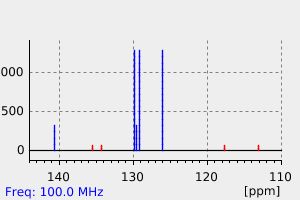(2Z,2'Z)-3,3'-(1,4-phenylene)bis(2-phenylacrylonitrile) | 58393-80-9
中文名称
——
中文别名
——
英文名称
(2Z,2'Z)-3,3'-(1,4-phenylene)bis(2-phenylacrylonitrile)
英文别名
(cis,cis)-1,4-bis(2-cyano-2-phenylethenyl)benzene;1,4-bis(2-cyano-2-phenylethenyl)benzene;2,2'-diphenyl-3,3'-p-phenylene-di-acrylonitrile;2,2'-Diphenyl-3,3'-p-phenylen-di-acrylonitril;1.4-Bis-(β-cyan-styryl)-benzol;(Z)-3-[4-[(Z)-2-cyano-2-phenylethenyl]phenyl]-2-phenylprop-2-enenitrile
CAS
58393-80-9
化学式
C24H16N2
mdl
——
分子量
332.404
InChiKey
WSDKHZCNLDFRFB-DFEHQXHXSA-N
BEILSTEIN
——
EINECS
——
-
物化性质
-
计算性质
-
ADMET
-
安全信息
-
SDS
-
制备方法与用途
-
上下游信息
-
文献信息
-
表征谱图
-
同类化合物
-
相关功能分类
-
相关结构分类
计算性质
-
辛醇/水分配系数(LogP):5.5
-
重原子数:26
-
可旋转键数:4
-
环数:3.0
-
sp3杂化的碳原子比例:0.0
-
拓扑面积:47.6
-
氢给体数:0
-
氢受体数:2
反应信息
-
作为反应物:描述:(2Z,2'Z)-3,3'-(1,4-phenylene)bis(2-phenylacrylonitrile) 在 碘 作用下, 以 甲苯 为溶剂, 反应 36.0h, 以83%的产率得到5,10-dicyano[5]helicene参考文献:名称:Facile Photochemical Synthesis of 5,10-Disubstituted [5]Helicenes by Removing Molecular Orbital Degeneracy摘要:Photocyclodehydrogenation is a key reaction to synthesize helicenes; however, because of overannulation, it is not applicable to the synthesis of [S]helicene. Introduction of a cyano group was found to remove the orbital degeneracy of the low-lying unoccupied MOs; consequently, the lowest excitation comprises a single transition involving the C-2-antisymmetric MO. Therefore, the problematic overannulation can be effectively suppressed. Moreover, in combination with the Knoevenagel reaction, a one-pot synthesis of 5,10-dicyano[5]helicene with 67% yield was accomplished.DOI:10.1021/ol5008718
-
作为产物:参考文献:名称:Supramolecular interaction-induced self-assembly of organic molecules into ultra-long tubular crystals with wave guiding and amplified spontaneous emission摘要:通过物理气相法成功制备了有机小分子1,4-双(2-氰基-2-苯基乙烯基)苯(BCPEB)的超长管状晶体(长度可达10毫米,直径为70微米)运输(PVT)方法。在晶体结构分析和密度泛函理论计算的基础上,我们表明这种管状晶体的形成是由BCPEB分子之间的支化氢键引起的。高结晶质量、高度有序的分子取向和中空拓扑结构使晶体表现出低光损耗(3 dB mm−1)和高偏振发射(偏振比约为20)的光波导发射行为。还研究了管状晶体的放大自发发射(ASE)特性;峰值波长和阈值处的净增益系数分别为 91.7 cm−1 和 36 kW cm−2。DOI:10.1039/c1jm14815j
文献信息
-
Exploring the minimal structure of a wholly aromatic organogelator: simply adding two β-cyano groups to distyrylbenzene作者:Seong-Jun Yoon、Jong H. Kim、Jong Won Chung、Soo Young ParkDOI:10.1039/c1jm14558d日期:——The minimal structure of a wholly Ï-conjugated aromatic organogelator was explored in this work to show that distyrylbenzene with simple β-cyano substitution (β-DCS) is highly efficient for gelation which is attributed to the cooperative interplay of ÏâÏ stacking and secondary bonding interactions of dipolar cyano groups.
-
Kauffmann, Chemische Berichte, 1917, vol. 50, p. 526作者:KauffmannDOI:——日期:——
表征谱图
-
氢谱1HNMR
-
质谱MS
-
碳谱13CNMR
-
红外IR
-
拉曼Raman
-
峰位数据
-
峰位匹配
-
表征信息
同类化合物
(E,Z)-他莫昔芬N-β-D-葡糖醛酸
(E/Z)-他莫昔芬-d5
(4S,5R)-4,5-二苯基-1,2,3-恶噻唑烷-2,2-二氧化物-3-羧酸叔丁酯
(4S,4''S,5R,5''R)-2,2''-(1-甲基亚乙基)双[4,5-二氢-4,5-二苯基恶唑]
(4R,5S)-4,5-二苯基-1,2,3-恶噻唑烷-2,2-二氧化物-3-羧酸叔丁酯
(4R,4''R,5S,5''S)-2,2''-(1-甲基亚乙基)双[4,5-二氢-4,5-二苯基恶唑]
(1R,2R)-2-(二苯基膦基)-1,2-二苯基乙胺
鼓槌石斛素
黄子囊素
高黄绿酸
顺式白藜芦醇三甲醚
顺式白藜芦醇
顺式己烯雌酚
顺式-白藜芦醇3-O-beta-D-葡糖苷酸
顺式-桑皮苷A
顺式-曲札芪苷
顺式-二苯乙烯
顺式-beta-羟基他莫昔芬
顺式-a-羟基他莫昔芬
顺式-3,4',5-三甲氧基-3'-羟基二苯乙烯
顺式-1-(3-甲基-2-萘基)-2-(2-萘基)乙烯
顺式-1,2-双(三甲基硅氧基)-1,2-双(4-溴苯基)环丙烷
顺式-1,2-二苯基环丁烷
顺-均二苯乙烯硼酸二乙醇胺酯
顺-4-硝基二苯乙烯
顺-1-异丙基-2,3-二苯基氮丙啶
非洲李(PRUNUSAFRICANA)树皮提取物
阿非昔芬
阿里可拉唑
阿那曲唑二聚体
阿托伐他汀环氧四氢呋喃
阿托伐他汀环氧乙烷杂质
阿托伐他汀环(氟苯基)钠盐杂质
阿托伐他汀环(氟苯基)烯丙基酯
阿托伐他汀杂质D
阿托伐他汀杂质94
阿托伐他汀杂质7
阿托伐他汀杂质5
阿托伐他汀内酰胺钠盐杂质
阿托伐他汀中间体M4
阿奈库碘铵
锌(II)(苯甲醛)(四苯基卟啉)
银松素
铜酸盐(5-),[m-[2-[2-[1-[4-[2-[4-[[4-[[4-[2-[4-[4-[2-[2-(羧基-kO)苯基]二氮烯基-kN1]-4,5-二氢-3-甲基-5-(羰基-kO)-1H-吡唑-1-基]-2-硫代苯基]乙烯基]-3-硫代苯基]氨基]-6-(苯基氨基)-1,3,5-三嗪-2-基]氨基]-2-硫代苯基]乙烯基]-3-硫代
铒(III) 离子载体 I
铀,二(二苯基甲酮)四碘-
钾钠2,2'-[(E)-1,2-乙烯二基]二[5-({4-苯胺基-6-[(2-羟基乙基)氨基]-1,3,5-三嗪-2-基}氨基)苯磺酸酯](1:1:1)
钠{4-[氧代(苯基)乙酰基]苯基}甲烷磺酸酯
钠;[2-甲氧基-5-[2-(3,4,5-三甲氧基苯基)乙基]苯基]硫酸盐
钠4-氨基二苯乙烯-2-磺酸酯







